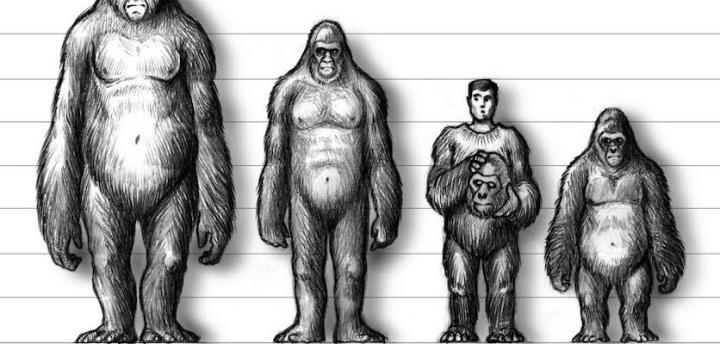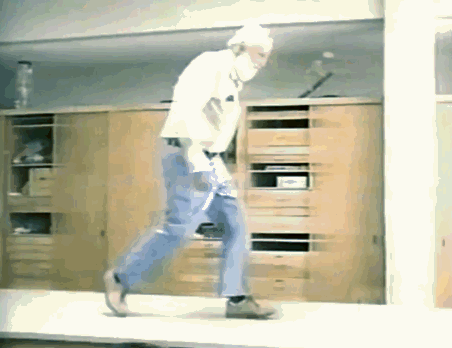The Man, The Myth, and The Legend of Grover Krantz
Posted by: Craig Woolheater on June 29th, 2018

By Krissy Eliot
California Magazine
In the early 1990s in Sequim, Washington, on the heavily forested Olympic Peninsula, anthropologist Grover Krantz was building a helicopter to search for Sasquatch. He ordered the kit from some guy in the Midwest and spent several years trying to assemble it. He hoped the craft would provide the aerial view necessary to locate and retrieve a Bigfoot carcass.
“My attempt to build and fly an ultralight helicopter and use an infrared imager to locate a decaying body [of Sasquatch] so far has failed,” Krantz told a reporter in a TV interview. “I finally figured out what the problem was [with the helicopter assembly], but for three years now, I haven’t had the chance to correct the situation.”
He planned to make one last attempt in the summer, he said, and insisted no reporters be there for the flight. “I don’t want somebody photographing my bloody body as it’s dragged out of the wreckage,” Krantz said, only half-joking.
Until his death in 2002, Krantz was unwaveringly dedicated to the search for Bigfoot, and was willing to risk life, limb, and career to discover it. When a reporter asked Krantz what the likelihood was that Sasquatch existed, he replied without hesitation, “Guaranteed.”
So what exactly convinced Krantz, an anthropology professor at Washington State with two degrees from UC Berkeley, that Bigfoot was real?

Grover Krantz mimics the Bigfoot stride in TV interview.
It all started with a movie.
Though Krantz was mildly interested in anomalous primates since he was a teenager, it wasn’t until the 1960s when he saw the famous Patterson-Gimlin film—supposedly the first known footage of a Bigfoot walking through the woods near Bluff Creek in Humboldt County, California—that he took up the cause.
From Krantz’s point of view, the Patterson-Gimlin Bigfoot’s strides and arm movements weren’t easily mimicable by a human and could not be sustained for more than a few steps, which to Krantz, proved the film’s validity.
“The Patterson subject walks with the body leaning forward, and with the knees largely bent, so that when it takes a step, it supports the leg with a bent knee and keeps two feet on the ground for an unusual length of time,” Krantz told the Discovery Channel, demonstrating the stride by leaning forward and lifting his feet up high as if walking through mud. His tone was certain and his strut confident.
Later, Krantz would become even more convinced of Bigfoot’s genuineness with the discovery of “Cripplefoot,” a print found in Bossburg, Washington, a ghost town near the Canadian border. He studied casts of this print and donated copies of it to UC Berkeley’s Phoebe A. Hearst Museum of Anthropology, which displayed the casts in an exhibit on Darwin Day in 2008. What made this footprint different was that it appeared to be authentically deformed; to Krantz, the impression made in the dirt indicated that a truly heavy, crippled beast had left it, not a human hoaxer. Krantz decided that any person who could fake that footprint would have to be as educated as he was, something Krantz highly doubted.
“If somebody faked that and put all of the subtle hints of the anatomy design in that, he had to be a real genius, an expert at anatomy, and very inventive and original in thinking,” Krantz said. “He had to outclass me in those areas, and I don’t think anybody outclasses me in those areas. At least not since Leonardo Da Vinci, and I’d say such a person is impossible and therefore the tracks were real.”
Later in his research, Krantz would go on to conclude that Bigfoot was likely Gigantopithecus, an extinct Asian primate that existed from perhaps nine million to one hundred thousand years ago. He thought they may have migrated to North America via the Bering Strait when it was still a land bridge. Though scientists have yet to discover a full fossil skeleton of the creature, Krantz examined a mandible and theorized that it walked upright, bipedally, and that it shared many characteristics with Sasquatch.
Of course, Krantz knew that his theories counted for nothing until he could produce irrefutable evidence in the form of a body… which is why he’d spend many a night cruising the Washington backroads alone with a spotlight and a shotgun. This made him unpopular among many cryptozoologists, amateur researchers who study and search for animals described in legend and folklore.
Krantz’s plan to kill a Bigfoot “was a political hot potato,” said Idaho State University anatomy and anthropology professor Jeffrey Meldrum, a colleague of Krantz’s who continues the search for Sasquatch. “It divided the Bigfoot community right down the middle with strong feelings on both sides.”
If Bigfoot were a real creature and if Krantz were to shoot one, he might be helping to kill off the species for the sake of his own research, something many Bigfoot believers find unconscionable, Meldrum explained. But Krantz’s point was that no one would bother to preserve the species until it was recognized by science, which is why he was determined to bring in a corpse.
“It has not yet been established that the Sasquatch exists,” Krantz wrote in his book The Scientist Looks at Sasquatch. “To pass laws against harming sasquatches presently makes little more sense than protecting unicorns.”
“I wrestled with the issue mentally and ethically and so forth for a long time,” said Meldrum, who eventually took the opposing position, deciding it was wrong to kill one no matter what the circumstance. “But I’m not passing judgment on Grover for that.”
Though Krantz would have preferred to find a specimen that died of natural causes, he knew the likelihood of that was slim to none. It’s actually difficult to find remains of any species, Krantz explained in The Scientist Looks at Sasquatch, partly because remains are usually carried off by other creatures for sustenance.
Still, Krantz thought it was possible.
In fact, many species that were formerly thought to be fixtures of mythology have been found among us, including giant squid, manatees, and mountain gorillas. These discoveries help explain why a growing number of modern scientists and academics think that cryptozoology, though often dismissed as pseudoscience, deserves more respect.
“Cryptozoology is really the study of those things that lead up to the discovery and verification of a creature. For instance, the mountain gorilla which was reported and seen and talked about in folklore for hundreds of years was not verified as animal until 1901,” said author and cryptozoologist Loren Coleman, a friend of Krantz, in an interview with Radio New Zealand. “It took scientists over 60 years of tracking the first giant panda before they discovered it. And Bigfoot has really only been pursued, and not even by scientists…for just 50 years.”
Though Krantz never found a Bigfoot dead or alive, he had what he thought were close calls. Once, returning from an expedition with students in central Washington, Krantz was driving through a snowstorm when something large and brown loped quickly across the road, causing Krantz to slam on the brakes, said Krantz’s former student, archeologist and physical anthropologist Gary Breschini. The group piled out of their vehicle and started tracking the creature with vigor, until someone finally asked: “What are we doing in a snowstorm tracking something that might be 800 pounds? And what do we do if we catch it?” They gave up the search, disappointed yet exhilarated.
Breschini said that even though Krantz made his share of enemies in Washington State’s anthropology department, his students adored him. He made friends with them and was always game to hang out and chat over lunch—which for him usually consisted of a cigarette, a cup of coffee, and two chocolate donuts. He pushed his students to be original in their thinking, Breschini said, and to challenge commonly held ideas.
“We were free to come up with ideas that were contrary to what everyone else was coming up with,” Breschini said. “He let us think outside the box, and the nice thing about it was, he made us defend our attempts to think outside the box.”
To learn more about Grover, his early life and influences, his Mormon background, and his love of other large, furry creatures, click here. To read about other scientists and academics who have come around to the idea of Bigfoot research, click here. And if you’re still curious, check out our piece on why people choose to believe in legends like Sasquatch in the first place; according to folklore experts, the reasons for believing might be more normal than you’d think.
Read the rest of the article here.
‘Usual Suspects” illustration by Rick Spears
About Craig Woolheater
Co-founder of Cryptomundo in 2005.
I have appeared in or contributed to the following TV programs, documentaries and films:
OLN's Mysterious Encounters: "Caddo Critter", Southern Fried Bigfoot, Travel Channel's Weird Travels: "Bigfoot", History Channel's MonsterQuest: "Swamp Stalker", The Wild Man of the Navidad, Destination America's Monsters and Mysteries in America: Texas Terror - Lake Worth Monster, Animal Planet's Finding Bigfoot: Return to Boggy Creek and Beast of the Bayou.









Grover Krantz was a pioneer in the field to be sure and he had a lot of ideas that were ahead of the times.
I didn’t know about his pro-kill position, but I understand why he would have gone down that path: years of hunting and not coming up with the proof would have been frustrating–as it is for all cryptid hunters.
I wrestle with that position daily–with all cryptids. With something like bigfoot, there is enough secondary evidence to know there is something out there that defies all of the usual explanations and scoftic arguments. And with all of the criticism and eye rolling, and the only main argument naysayers always fall back on: show me a body, it’s no wonder bigfoot hunters shift on this position. And there seems to be a growing faction in favor of killing one.
Proving Bigfoot exists by getting a body is conclusive and I am tempted like all of the others. On the other hand, if I came across one and had to pull the trigger to prove it exists and put the question to rest once and for all (and let’s face it, a small part of all of us would love to hand out the “I told you so’s”), I still don’t know if I’d do it or not.